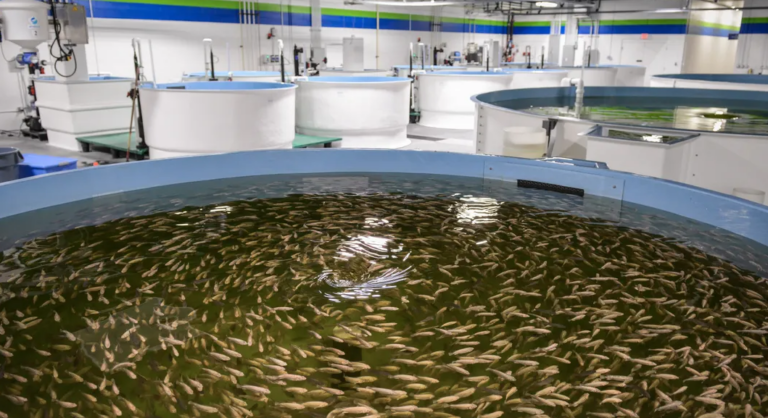Aquaculture, farming aquatic organisms, plays a critical position in assembling the arena’s developing demand for seafood. As the populace increases, so does the need for sustainable and green aquaculture methods. One modern method that has been gaining traction is Recirculating Aquaculture Systems (RAS). Erik Heim says
At the heart of RAS’s success lies the function of automation.
Table of Contents
RAS: A Sustainable Solution
RAS is a closed-loop machine that recirculates and filters water within the aquaculture facility, minimizing the need for significant volumes of water. This conserves water resources and decreases the environmental impact of conventional open-water aquaculture systems. However, the genuine ability of RAS is unlocked when automation technology is integrated into the device.
Monitoring And Controlling Water Parameters
Water quality is crucial for the fitness and growth of aquatic organisms. Maintaining gold-standard water situations in conventional aquaculture structures can be challenging. However, with automation in RAS, sensors and control structures constantly display parameters, which include temperature, pH, dissolved oxygen, and ammonia stages.
Automation guarantees that those situations continue to be in the favoured variety, growing an environment conducive to the nicely-being of the aquatic species. This complements the survival fees of the organisms and improves their increased charges. It ultimately ends in higher production yields.
Feeding Precision For Optimal Growth
Proper nutrition is fundamental in aquaculture, and precision in feeding is paramount. Automation in RAS permits for the correct shelling out of feed based on the precise needs of the aquatic species. This removes overfeeding, decreasing production expenses and stopping water pollution as a result of extra uneaten feed.
Automated feeding structures can be programmed to distribute feed at ideal periods and mirror natural feeding patterns. This enhances the health and increase of the aquatic organisms and contributes to the aquaculture operation’s usual efficiency.
Disease Prevention And Early Detection
Disease outbreaks pose a good sized danger to aquaculture. Rapid response is essential to prevent the spread of infections and limit losses. Automation in RAS allows the continuous tracking of aquatic organisms’ health reputation through sensors and imaging technology.
In the occasion of any abnormalities or symptoms of contamination, computerized structures can trigger immediate responses. They can isolate affected people or alter water remedy parameters. Early detection and intervention play an essential role in stopping the escalation of illnesses and safeguarding the general fitness of the aquaculture system.
Energy Efficiency And Cost Savings
Automation improves the efficiency of aquaculture operations and contributes to financial savings in electricity costs. Monitoring and controlling systems can optimize strength-in-depth components, which include pumps and aerators, by adjusting their operation primarily based on actual-time information.
Furthermore, automation permits scheduling tasks at some point of off-height electricity hours, lowering power prices. This advantages the economic sustainability of aquaculture and aligns with the broader intention of reducing the industry’s environmental footprint.
Minimizing Environmental Impact
Waste management is an essential issue of sustainable aquaculture. Automated Recirculating Aquaculture Systems (RAS) are critical to addressing this assignment. In traditional structures, waste buildup can lead to water pollution, harming ecosystems.
Automated RAS employs superior filtration and sensor technologies to cast off and manage waste efficiently. Control systems optimize biofilters, breaking down harmful materials and changing waste into precious ones by using merchandise. This prevents environmental pollutants and allows for the recycling of waste materials, growing a closed-loop and eco-friendly aquaculture device.
Benefits of Automation in Aquaculture
Enhanced Efficiency in Resource Management
Automation streamlines approaches like feeding schedules, waste control, environmental manipulation, and lowering manual labour and human mistakes. This efficiency results in optimized helpful resource usage.
Increased Production Yields
The controlled surroundings in computerized RAS foster more healthy aquatic species, accelerating boom prices and improving universal production yields. Precise feeding schedules and water quality upkeep contributed extensively to this boom.
Environmental Sustainability
By minimizing water wastage and controlling environmental elements, automation in RAS promotes sustainability in aquaculture. This eco-friendly technique reduces the ecological footprint of fish farming.
Challenges and Solutions in Implementing Automation
Initial Investment and Cost Considerations
The advanced fee of implementing automation structures may pose a task. However, long-term benefits frequently outweigh those initial prices.
Integration with Existing Systems
Integrating new automation generation with current infrastructure requires cautious plans and know-how.
Training and Skill Development
Proper education applications are essential to equip personnel with the capabilities to operate and keep automatic structures efficiently.
Potential Impact on Aquaculture Industry
Anticipated shifts in the aquaculture industry due to the widespread adoption of automation and its implications for future growth and development.
Conclusion
Integrating automation technology into Recirculating Aquaculture Systems marks a substantial leap forward in the quest for sustainable and efficient aquaculture practices. As we navigate the demanding situations of feeding a developing international populace, the position of automation in aquaculture will become increasingly outstanding.
Erik Heim believes the future of sustainable seafood manufacturing lies within the palms of revolutionary technologies that beautify performance while minimizing environmental effects. Automated RAS stands as a beacon of desire, promising a more resilient and practical future for the aquaculture industry.

